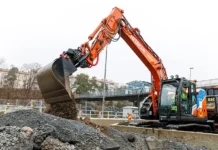Transforming Construction Through Circular Principles
The construction industry generates approximately 600 million tons of waste annually—a staggering figure representing roughly one-third of all global waste streams. Traditional linear construction models follow a take-make-dispose pathway that treats materials as temporary commodities rather than valuable resources. Circular construction practices fundamentally reimagine this relationship, viewing materials as assets that retain value through multiple life cycles and applications.
Circular construction practices represent far more than environmental sentiment. They constitute a comprehensive business strategy that reduces material costs, minimizes project delays caused by supply chain disruptions, and creates competitive advantages in increasingly sustainability-conscious markets. Organizations implementing resource efficiency frameworks consistently report both environmental benefits and measurable financial improvements.
Principles Underlying Circular Construction
The Circular Economy Framework
Circular construction builds upon circular economy principles developed across multiple industries. Rather than viewing infrastructure projects as isolated endeavors, circular approaches recognize how materials flow through interconnected systems where today’s waste becomes tomorrow’s resource. This perspective requires fundamental shifts in how industry participants conceptualize value, ownership, and responsibility.
The circular construction model operates through several overlapping loops. The technical cycle recovers materials that can be repeatedly reprocessed without quality degradation—metals, certain polymers, and minerals. The biological cycle enables organic materials including timber, cork, and natural fibers to safely return to soil, completing nutrient cycles. Effective circular construction practices strategically leverage both loops, selecting materials appropriate to their intended end-of-life pathways.
Design for disassembly represents a cornerstone principle differentiating circular construction from conventional approaches. Traditional construction prioritizes permanent bonding and integration of materials—concrete foundations anchor structural elements, adhesives permanently attach finishes, and multiple materials fuse together through layering and adhesion. Circular construction instead employs mechanical fastening systems allowing clean material separation at end-of-life.
This shift requires rethinking construction fundamentals. Rather than assuming permanence, circular construction embraces adaptability and temporal functionality. Structural systems designed for eventual disassembly prove surprisingly compatible with long-term durability when engineered thoughtfully. Standardized connection systems, modular design frameworks, and material compatibility considerations enable structures that serve their intended purpose while maintaining future recovery value.
Resource Efficiency in Material Selection and Sourcing
Lifecycle Material Assessment
Material selection profoundly influences circular construction outcomes. Lifecycle analysis conducted during design phases guides decisions that minimize total material throughput across project lifespan. Conventional sourcing focused primarily on initial cost and availability; circular material selection additionally weighs factors including recycled content percentages, recyclability at end-of-life, transportation distances, and processing requirements.
Reclaimed and salvaged materials have transitioned from specialty items to mainstream construction components. Salvaged timber from demolished structures, reclaimed brick from heritage buildings, and recovered metal elements provide authentic character while delivering circular construction benefits. Supply chains supporting material recovery have professionalized substantially, with certified operations ensuring quality, safety, and traceability of recovered materials.
Recycled content materials including recycled aggregate concrete, recycled plastic lumber, and reconstructed stone reduce extraction pressures on virgin resources. These materials perform comparably to conventional alternatives in most applications while substantially reducing embodied carbon and material extraction impacts. Transparency in recycled content documentation—often provided through Environmental Product Declarations (EPDs)—enables designers and builders to verify performance claims and document circular construction efforts.
Standardization and Material Compatibility
Material standardization accelerates circular construction implementation. When projects employ common dimensions, specifications, and component types, secondary markets for materials develop, creating economic incentives for recovery and reuse. Modular construction approaches leverage standardization to enable material sorting and recovery at end-of-life.
Cross-industry collaboration drives material compatibility advances. Construction industry partnerships with automotive and consumer goods sectors enable application of proven recycling infrastructure to building materials. Shared standards for material composition, marking systems, and processing methods streamline recovery operations significantly.
Waste Reduction and On-Site Resource Management
Construction Phase Waste Minimization
Circular construction practices prioritize waste reduction at the source rather than treating disposal as inevitable. Precise material quantities calculated through BIM (Building Information Modeling) prevent overordering while detailed construction sequencing minimizes waste generation during assembly phases.
Prefabrication and modular construction dramatically reduce on-site waste compared to traditional methods. Factory-controlled environments enable precise material cutting with minimal offcuts, efficient packaging preventing damage, and organized logistics preventing material loss. Studies consistently demonstrate that modular construction generates 40-50% less waste than conventional site-built approaches.
On-site material recovery systems transform construction waste streams into usable resources. Concrete crushers reduce concrete debris into aggregate suitable for subbase or landscaping applications. Timber sorting systems separate reusable pieces from trim waste, with viable materials redirected to secondary manufacturers. Organized material segregation during construction enables recovery rather than landfilling mixed waste streams.
Circular Construction Site Operations
Progressive construction organizations implement material tracking systems that monitor what enters and leaves project sites. Digital documentation systems maintain material inventories, enabling real-time decisions about reuse opportunities. When supply chain delays threaten schedules, available recovered materials provide alternatives while supporting circular construction objectives.
Subcontractor engagement proves critical for on-site resource efficiency. Training programs educating trade workers in waste reduction and material recovery techniques embed circular practices throughout construction operations. When electricians, plumbers, and equipment operators understand resource efficiency objectives and recovery procedures, waste generation decreases substantially.
Designing for Future Disassembly and Adaptation
Modular Design Frameworks
Modular construction enables buildings to evolve across decades while maintaining resource efficiency. Rather than permanent configurations, modular approaches anticipate changing functional requirements—wall systems relocate, mechanical systems upgrade, and spatial divisions adapt to new uses. This flexibility extends building service life, deferring or eliminating demolition through adaptive reuse.
Technical design standards for modular systems continue advancing. Standardized connection interfaces enable interchangeability of components, allowing obsolete elements to disconnect cleanly from functional systems. Modular facades, floor systems, and mechanical packages can be replaced independently without affecting remaining infrastructure, enabling buildings to refresh sustainably across their operational lifespans.
Material Passport Systems
Material passports represent innovative documentation approaches supporting circular construction objectives. These digital or physical records identify all materials within a structure, including composition, quantity, location, and recovery requirements. When renovation or demolition becomes necessary, material passports streamline recovery efforts, enabling efficient sorting and directing materials to appropriate secondary markets.
Implementing material passports requires standardized classification systems and documentation protocols. The European Union’s Circular Economy Action Plan promotes building-level material passports, establishing infrastructure supporting secondary material markets. As this practice expands globally, economic incentives increasingly favor disassembly and material recovery over conventional demolition and disposal.
Business Models Supporting Circular Construction
Product-Service Systems and Material Leasing
Innovative business models decouple material ownership from building occupancy. Manufacturers retaining material ownership through leasing arrangements create direct incentives for material recovery at end-of-life. This approach proves particularly effective for specialty materials—advanced insulation, renewable energy systems, or advanced finishes—where recovery value justifies logistics and processing costs.
Performance-based contracting aligns contractor interests with resource efficiency objectives. Rather than compensation based on material volume or construction cost, performance contracts reward contractors for delivering functional buildings with minimized material throughput. This fundamental realignment transforms material waste from externality to direct cost factor.
Marketplace Development for Secondary Materials
Successful circular construction practices require functional secondary material markets. Digital platforms connecting construction projects requiring materials with demolition or manufacturing operations generating surpluses streamline material flows significantly. Standardized material descriptions, quality verification procedures, and transparent pricing enable these marketplaces to operate efficiently.
Demolition service providers increasingly operate as material recovery operations rather than pure waste disposal businesses. Advanced sorting technologies enable economically viable recovery of mixed waste streams, transforming building demolition from waste-generation activity to resource extraction operation. This fundamental reframing creates economic incentives aligning with circular construction objectives.
Regulatory Frameworks and Market Drivers
Policy Evolution Supporting Circular Construction
Governments increasingly mandate circular construction practices through regulatory mechanisms. Building codes incorporating design for disassembly requirements, procurement standards favoring recycled content materials, and extended producer responsibility frameworks create market conditions favoring circular approaches. European Union regulations imposing construction waste targets drive industry adaptation throughout member states.
Public procurement policies wield substantial influence. When government agencies specify recycled content requirements, local sourcing preferences, and disassembly design standards in building contracts, market demand follows. These purchasing decisions signal long-term commitment to circular construction, encouraging manufacturers and contractors to develop supporting capabilities.
Financial Incentives and Green Finance
Sustainable financing mechanisms increasingly reward circular construction practices. Green bonds, impact financing, and environmental performance guarantees offer favorable terms for projects demonstrating reduced material throughput and lifecycle environmental benefits. These financial instruments translate environmental objectives into economic advantage, accelerating market adoption.
Insurance industry adaptation supports circular construction expansion. Underwriters increasingly recognize that structures designed for disassembly and material recovery present lower long-term liability profiles compared to buildings generating hazardous demolition waste. Insurance premium adjustments reflecting these risk assessments create additional economic incentives for circular design approaches.
Implementation Challenges and Future Pathways
Widespread circular construction adoption faces persistent obstacles. Existing supply chains, labor training, and regulatory frameworks evolved supporting linear models; transitioning these systems requires coordinated action across fragmented industry sectors. Cost premiums for specialized design and prefabrication components create initial hurdles, though lifecycle analysis consistently demonstrates financial justification across extended timeframes.
Advancing circular construction practices demands collaborative industry transformation. Design professionals must internalize disassembly considerations; manufacturers must redesign products supporting material recovery; contractors must implement waste reduction practices; and regulators must establish supportive frameworks. As these stakeholders increasingly recognize mutual benefits, circular construction practices transition from progressive niche to mainstream standard.
The construction industry’s resource efficiency future depends upon normalizing circular construction practices across all project scales and types. Organizations leading this transition position themselves advantageously while contributing to environmental objectives increasingly demanded by markets, regulators, and society alike.






























